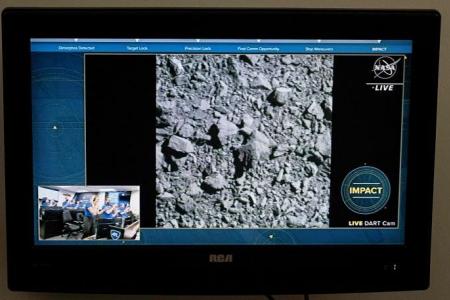Nasa's Dart spacecraft hits target asteroid in test of planetary defence system
LOS ANGELES - Hurtling through the solar system at hypersonic speed, Nasa's Dart spacecraft on Tuesday successfully slammed itself into an asteroid some 11 million km from Earth in a test of the world's first planetary defence system, designed to prevent a potential doomsday meteorite collision with Earth.
“In case you’re keeping score: humanity 1, asteroids 0,” Ms Tahira Allen, a Nasa spokesman, said during a livestream after the impact.
The finale to the suicide spaceflight, humanity's first attempt to alter the motion of an asteroid or any celestial body, played out in a Nasa webcast from the mission operations centre outside Washington, 10 months after Dart was launched.
The livestream showed images taken by Dart's own camera as the cube-shaped "impactor" vehicle, no bigger than a vending machine with two rectangular solar arrays, streaked into the asteroid Dimorphos, about the size of a football stadium, at around 7pm EDT (7am in Singapore).
A separate, toaster-size satellite, deployed from Dart prior to impact, also captured images of the collision. Nasa has said it will share those images in the coming days.
Various Nasa space telescopes, including Hubble and James Webb, also observed the impact.
Up until five minutes before impact, mission controllers could have intervened if something had gone wrong. After that, they too were just spectators like everyone watching the stream of photographs of Dimorphos getting bigger and bigger.
Cheers could be heard from engineers in the control room as second-by-second images of the target asteroid grew larger and ultimately filled the TV screen of Nasa's live webcast just before the spacecraft's signal was lost, confirming it had successfully crashed into Dimorphos at more than 22,000 kmh.
“We’re embarking on a new era, an era in which we potentially have the capability to protect ourselves from something like a dangerous hazardous asteroid impact,” said Ms Lori Glaze, director of Nasa’s planetary science division.
Now, we wait
The mission was devised to determine whether a spacecraft is capable of changing the trajectory of an asteroid through sheer kinetic force, nudging it off course just enough to keep Earth out of harm's way.
Whether it succeeded beyond accomplishing its intended impact will not be known until further ground-based telescope observations of the asteroid next month.
But Nasa officials hailed the immediate outcome of Tuesday's experiment, saying the spacecraft appeared to have performed as designed.
If measurements show the asteroid’s course was even slightly altered, Nasa will deem the mission a success.
“Nasa works for the benefit of humanity. So, for us it’s the ultimate fulfilment of our mission to do something like this, a technology demonstration that, who knows, some day could save our home,” Nasa Deputy Administrator Palm Melroy, a retired astronaut, said minutes after the impact.
Dart, launched by a SpaceX rocket in November 2021, made most of its voyage under the guidance of Nasa's flight directors, with control handed over to an autonomous on-board navigation system in the final hours of the journey..
If in the future a hazardous asteroid is spotted heading towards Earth, it is possible that Nasa, or some other space agency, could send a spacecraft to ram it just as Dart has done.
Such an impact could impart just enough momentum to slightly change the asteroid’s trajectory so that, over time, it whizzes safely by Earth.
Planet killers
Dart's celestial target was an oblong asteroid “moonlet” about 170m in diameter that orbits a parent asteroid five times larger called Didymos as part of a binary pair with the same name, the Greek word for twin.
Neither object presents any actual threat to Earth, and Nasa scientists said their Dart test could not create a new hazard by mistake.
Dimorphos and Didymos are both tiny compared with the cataclysmic Chicxulub asteroid that struck Earth some 66 million years ago, wiping out about three-quarters of the world’s plant and animal species, including the dinosaurs.
Smaller asteroids are far more common and present a greater theoretical concern in the near term, making the Didymos pair suitable test subjects for their size, according to Nasa scientists and planetary defence experts.
A Dimorphos-sized asteroid, while not capable of posing a planet-wide threat, could level a major city with a direct hit. Also, the two asteroids’ relative proximity to Earth and dual configuration make them ideal for the first proof-of-concept mission of Dart, short for Double Asteroid Redirection Test.
Now that Dart has rammed into Dimorphos, astronomers on Earth will observe the asteroid system with optical and radar telescopes over the coming weeks to see how the spacecraft changed the asteroid’s orbit around Didymos.
Just before impact, Dimorphos’ orbit around Didymos was at under 12 hours. The Dart team said it expects to shorten the orbital path of Dimorphos by 10 minutes, but would consider at least 73 seconds a success, proving the exercise as a viable technique to deflect an asteroid on a collision course with Earth – if one were ever discovered.
A small nudge to an asteroid millions of kilometres away years in advance could be sufficient to safely reroute it.
Astronomers have catalogued most of the giant asteroids that can destroy Earth, and none that have been identified so far pose a risk for the foreseeable future.
But astronomers believe they have found less than half of the many thousands of asteroids similar in size to Dimorphos that are flying near Earth. Were one of these rocks to ever crash into the planet, it could cause significant damage.
“This would be regionally devastating over a populated area, a city, a state, or a country,” said Ms Nancy Chabot, the coordination lead for Dart at the Johns Hopkins Applied Physics Laboratory. “So you might not be talking global extinction, but you still want to be able to prevent this if you could.”
But for now, said Dart mission systems engineer Elena Adams, "I think Earthlings can sleep better; definitely, I will." - REUTERS, BLOOMBERG, AFP
Get The New Paper on your phone with the free TNP app. Download from the Apple App Store or Google Play Store now


